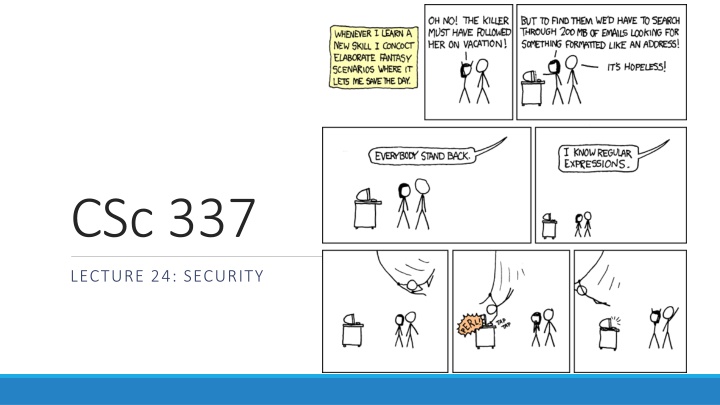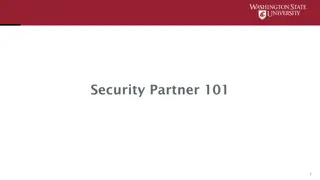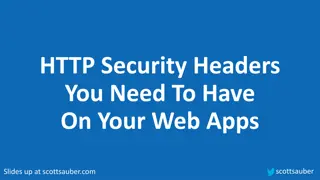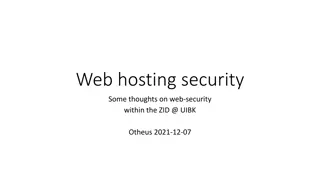Importance of Security in Web Development
Our perception of security has evolved to acknowledge the presence of malicious actors and potential vulnerabilities in web applications. To write secure code, developers must assume the worst-case scenario and adopt a security mindset that trusts no one. Attackers have various goals, such as stealing private data, altering information, and damaging a site's reputation. Understanding the tools attackers use and the types of attacks they employ is crucial for defending against security breaches. Information leakage poses a significant threat, allowing attackers unauthorized access to sensitive data. Awareness of potential vulnerabilities and proactive security measures are essential in safeguarding web applications.
Download Presentation

Please find below an Image/Link to download the presentation.
The content on the website is provided AS IS for your information and personal use only. It may not be sold, licensed, or shared on other websites without obtaining consent from the author.If you encounter any issues during the download, it is possible that the publisher has removed the file from their server.
You are allowed to download the files provided on this website for personal or commercial use, subject to the condition that they are used lawfully. All files are the property of their respective owners.
The content on the website is provided AS IS for your information and personal use only. It may not be sold, licensed, or shared on other websites without obtaining consent from the author.
E N D
Presentation Transcript
CSc 337 LECTURE 24: SECURITY
Our current view of security until now, we have assumed: valid user input non-malicious users nothing will ever go wrong this is unrealistic!
The real world in order to write secure code, we must assume: invalid input evil users incompetent users everything that can go wrong, will go wrong everybody is out to get you botnets, hackers, script kiddies, KGB, etc. are out there the security mindset: assume nothing; trust no one
Attackers' goals Why would an attacker target my site? Read private data (user names, passwords, credit card numbers, grades, prices) Change data (change a student's grades, prices of products, passwords) Spoofing (pretending to be someone they are not) Damage or shut down the site, so that it cannot be successfully used by others Harm the reputation or credibility of the organization running the site Spread viruses and other malware
Tools that attackers use Assume that the attacker knows about web dev and has the same tools you have: Firebug extensions e.g. Web Dev Toolbar port scanners, e.g. nmap network sniffers, e.g. Wireshark, EtherDetect, Firesheep
Some kinds of attacks Denial of Service (DoS): Making a server unavailable by bombarding it with requests. Social Engineering: Tricking a user into willingly compromising the security of a site (e.g. phishing). Privilege Escalation: Causing code to run as a "privileged" context (e.g. "root"). Information Leakage: Allowing an attacker to look at data, files, etc. that he/she should not be allowed to see. Man-in-the-Middle: Placing a malicious machine in the network and using it to intercept traffic. Session Hijacking: Stealing another user's session cookie to masquerade as that user. Cross-Site Scripting (XSS) or HTML Injection: Inserting malicious HTML or JavaScript content into a web page. SQL Injection: Inserting malicious SQL query code to reveal or modify sensitive data.
Information leakage when the attacker can look at data, files, etc. that he/she should not be allowed to see files on web server that should not be there or have too generous of permissions (read/write to all) directories that list their contents (indexing) can be disabled on web server guess the names of files, directories, resources see loginfail.html, try loginsuccess.html see user.html?id=123, try user.html?id=456 see /data/public, try /data/private
Man-in-the-middle attack when the attacker listens on your network and reads and/or modifies your data works if attacker can access and compromise any server/router between you and your server also works if you are on the same local area network as the attacker often, the attacker still sends your info back and forth to/from the real server, but he silently logs or modifies some of it along the way to his own benefit e.g. listens for you to send your user name / password / credit card number / ...
Secure HTTP (HTTPS) HTTPS: encrypted version of HTTP protocol all messages between client and server are encrypted so men in the middle cannot easily read them servers can have certificates that verify their identity
Session hijacking when the attacker gets a hold of your session ID and masquerades as you exploit sites that use HTTPS for only the initial login: HTTPS: browser server (POST login.html) HTTPS: browser server (login.html + PHPSESSID cookie) HTTP: browser server (GET whatever.html + PHPSESSID cookie) HTTP: browser server (whatever.html + PHPSESSID cookie) attacker can listen to the network, get your session ID cookie, and make requests to the same server with that same session ID cookie to masquerade as you! example: Firesheep
HTML injection a flaw where a user is able to inject arbitrary HTML content into your page This flaw often exists when a page accepts user input and inserts it bare into the page. example: magic 8-ball (8ball.html) What kinds of silly or malicious content can we inject into the page? Why is this bad?
Injecting HTML content 8ball_service.js?question=<em>lololol</em> injected content can lead to: annoyance / confusion damage to data on the server exposure of private data on the server financial gain/loss end of the human race as we know it why is HTML injection bad? It allows others to: disrupt the flow/layout of your site put words into your mouth possibly run malicious code on your users' computers
Cross-site scripting (XSS) a flaw where a user is able to inject and execute arbitrary JavaScript code in your page 8ball_service.js?question=<script type='text/javascript'>alert('pwned');</script> JavaScript is often able to be injected because of a previous HTML injection Try submitting this as the 8-ball's question in Firefox: <script type="text/javascript" src="http://panzi.github.com/Browser-Ponies/basecfg.js" id="browser-ponies-config"></script><script type="text/javascript" src="http://panzi.github.com/Browser-Ponies/browserponies.js" id="browser-ponies-script"></script><script type="text/javascript">/* <![CDATA[ */ (function (cfg) {BrowserPonies.setBaseUrl(cfg.baseurl);BrowserPonies.loadConfig(BrowserPoniesBaseConfig);BrowserPonies.loadConfig(cfg);})({"baseurl ":"http://panzi.github.com/Browser- Ponies/","fadeDuration":500,"volume":1,"fps":25,"speed":3,"audioEnabled":false,"showFps":false,"showLoadProgress":true,"speakProbab ility":0.1,"spawn":{"applejack":1,"fluttershy":1,"pinkie pie":1,"rainbow dash":1,"rarity":1,"twilight sparkle":1},"autostart":true}); /* ]]> */</script> injected script code can: masquerade as the original page and trick the user into entering sensitive data steal the user's cookies masquerade as the user and submit data on their behalf (submit forms, click buttons, etc.) ...
Securing against HTML injection / XSS one idea: disallow harmful characters HTML injection is impossible without < > can strip those characters from input, or reject the entire request if they are present another idea: allow them, but escape them You can do this yourself using regular expressions but a library is more reliable Use a library called htmlspecialcharacters npm install htmlspecialcharacters var htmlspecialchars = require('htmlspecialchars'); $text = "<p>hi 2 u & me</p>"; $text = htmlspecialchars($text); # "<p>hi 2 u & me</p>"
SQL injection a flaw where the user is able to inject arbitrary SQL into your query This flaw often exists when a page accepts user input and inserts it bare into the query. What kinds of SQL can we inject into the query? Why is this bad?
A SQL injection attack The query in the Simpsons Node code is: let query = "SELECT * FROM students WHERE username = '" + username + "' AND password = '" + password + "'"; JS Are there malicious values for the user name and password that we could enter? Password: This causes the query to be executed as: query = "SELECT * FROM students WHERE username = '" + username+ "' AND password = '' OR '1'='1'"; What will the above query return? Why is this bad? ' OR '1'='1
Too true... injected SQL can: change the query to output others' data (revealing private information) insert a query to modify existing data (increase bank account balance) delete existing data (; DROP TABLE students; -- ) bloat the query to slow down the server (JOIN a JOIN b JOIN c ...) ...
Securing against SQL injection similar to securing against HTML injection, escape the string before you include it in your query con.escape returns a SQL-escaped version of a string username = con.escape(query.username); password = con.escape(query.password); query = "SELECT name, ssn, dob FROM users WHERE username = $username AND password = $password"; PHP replaces ' with \', etc., and surrounds with quotes























